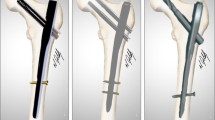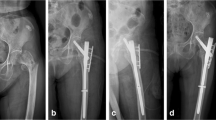Abstract
Purpose
This study was designed to compare clinical outcomes of the femoral stable interlocking intramedullary nail (FSIIN) with proximal femoral nail anti-rotation (PFNA) for the treatment of intertrochanteric fractures (OTA 31A1 + A2).
Methods
This study retrospectively analyzed a registered sample of 74 intertrochanteric fractures (OTA 31A1 + A2) surgically treated using FSIIN (n = 36) or PFNA (n = 38) from January 2015 to December 2021. The intra-operative variables (operation time, fluoroscopy time, intra-operative blood loss, length of incision) and fracture healing time were compared between the two groups in this study. Harris hip score (HHS) and visual analog scale (VAS) were used to evaluate the functional states. At the last follow-up, the incidence of related complications in patients was calculated. Eventually, the 3D finite element model was established to analyze the stress of FSIIN and PFNA.
Results
The distribution of all basic characteristics was similar between the two groups (p > 0.05). The operation time, fluoroscopy time, intra-operative blood loss, and length of incision were significantly decreased in the FSIIN group (p < 0.001). The FSIIN group had a shorter fracture healing time than the PFNA group (p < 0.001). There is no significant difference between the two groups in the Harris and VAS (p > 0.05). The incidences of post-operative anaemia, electrolyte imbalance, varus malalignment, and thigh pain were significantly lower in FSIIN than in PFNA groups (all p < 0.05). The finite element results show that the stress shielding effect of FSIIN is smaller.
Conclusions
Our study revealed that FSIIN seemed to be superior to PFNA in the treatment of intertrochanteric fractures (OTA 31A1 + A2) due to less surgical damage and shorter fracture healing time.




Similar content being viewed by others
Data availability
Data and materials during the current study are available from the corresponding author on reasonable request.
Code availability
Mimics 21.0 Software (Materialise Corporation, Leuven, Belgium); Geomagic-Studio 11 software (Raindrop Corporation, NC, USA); Abaqus 6.14 Software (Dassault Corporation, Paris, France); SPSS 26.0 Software (IBM Corporation, Armonk, NY, USA).
References
Zhang Z, Qiu Y, Zhang Y, Zhu Y, Sun F, Liu J, Zhang T, Wen L (2022) Corrigendum: Global trends in intertrochanteric hip fracture research from 2001 to 2020: a bibliometric and visualized study. Front Surg 9:865369. https://doi.org/10.3389/fsurg.2022.865369
van Embden D, Rhemrev SJ, Meylaerts SA, Roukema GR (2010) The comparison of two classifications for trochanteric femur fractures: the AO/ASIF classification and the Jensen classification. Injury 41(4):377–381. https://doi.org/10.1016/j.injury.2009.10.007
Zhong G, Teng L, Li HB, Huang FG, Xiang Z, Cen SQ (2021) Surgical treatment of internal fixation failure of femoral peritrochanteric fracture. Orthop Surg 13(6):1739–1747. https://doi.org/10.1111/os.13110
Zhao K, Wang Z, Tian S, Hou Z, Chen W, Zhang Y (2022) Incidence of and risk factors for pre-operative deep venous thrombosis in geriatric intertrochanteric fracture patients. Int Orthop 46(2):351–359. https://doi.org/10.1007/s00264-021-05215-x
Fan J, Lv Y, Xu X, Zhou F, Zhang Z, Tian Y, Ji H, Guo Y, Yang Z, Hou G (2021) The efficacy of multidisciplinary team co-management program for elderly patients with intertrochanteric fractures: a retrospective study. Front Surg 8:816763. https://doi.org/10.3389/fsurg.2021.816763
Chang SM, Hou ZY, Hu SJ, Du SC (2020) Intertrochanteric femur fracture treatment in Asia: what we know and what the world can learn. Orthop Clin North Am 51(2):189–205. https://doi.org/10.1016/j.ocl.2019.11.011
Wang R, Zhang H, Wei Q, Ding C, Cao L, Yi M, Tong D, Li D, Fan Z, Wu D, Ji F, Tang H (2021) Intramedullary nails in combination with reconstruction plate in the treatment of unstable intertrochanteric femoral fractures with lateral wall damage. Int Orthop 45(11):2955–2962. https://doi.org/10.1007/s00264-021-05004-6
Cheng YX, Sheng X (2020) Optimal surgical methods to treat intertrochanteric fracture: a Bayesian network meta-analysis based on 36 randomized controlled trials. J Orthop Surg Res 15(1):402. https://doi.org/10.1186/s13018-020-01943-9
Gong H, Wang L, Zheng D, Fan Y (2012) The potential application of functionally graded material for proximal femoral nail antirotation device. Med Hypotheses 79(3):415–417. https://doi.org/10.1016/j.mehy.2012.06.013
Li X, Zhang L, Hou Z, Meng Z, Chen W, Wang P, Zhang Y (2015) Distal locked and unlocked nailing for perthrochanteric fractures–a prospective comparative randomized study. Int Orthop 39(8):1645–1652. https://doi.org/10.1007/s00264-015-2771-1
Skála-Rosenbaum J, Džupa V, Bartoška R, Douša P, Waldauf P, Krbec M (2016) Distal locking in short hip nails: cause or prevention of peri-implant fractures? Injury 47(4):887–892. https://doi.org/10.1016/j.injury.2016.02.009
Zheng L, Wong DW, Chen X, Chen Y, Li P (2022) Risk of proximal femoral nail antirotation (PFNA) implant failure upon different lateral femoral wall thickness in intertrochanteric fracture: a finite element analysis. Comput Methods Biomech Biomed Engin 25(5):512–520. https://doi.org/10.1080/10255842.2021.1964488
Yen S, Lu C, Ho C, Huang H, Tu H, Chang J, Chen C, Lin S (2021) Impact of wedge effect on outcomes of intertrochanteric fractures treated with intramedullary proximal femoral nail. J Clin Med 10(21):5112. https://doi.org/10.3390/jcm10215112
Chamay A, Tschantz P (1972) Mechanical influences in bone remodeling. Experimental research on Wolff’s law. J Biomech 5(2):173–180. https://doi.org/10.1016/0021-9290(72)90053-x
Hegde A, Khanna V, Mane P, Shetty C, Joseph N (2023) A comparative analysis of distal locked and unlocked long proximal femoral nail antirotation (PFNA-II) in the fixation of stable intertrochanteric fractures. Chin J Traumatol 26(2):111–115. https://doi.org/10.1016/j.cjtee.2022.12.007
Yang X, Wu Q, Wang X (2017) Investigation of perioperative hidden blood loss of unstable intertrochanteric fracture in the elderly treated with different intramedullary fixations. Injury 48(8):1848–1852. https://doi.org/10.1016/j.injury.2017.06.017
Grimaldi M, Courvoisier A, Tonetti J, Vouaillat H, Merloz P (2009) Superficial femoral artery injury resulting from intertrochanteric hip fracture fixation by a locked intramedullary nail. Orthop Traumatol Surg Res 95(5):380–382. https://doi.org/10.1016/j.otsr.2009.04.014
Han CD, Lee YH, Yang KH, Yang IH, Lee WS, Park YJ, Suh JS, Park KK (2013) Relationship between distal screws and femoral arteries in closed hip nailing on computed tomography angiography. Arch Orthop Trauma Surg 133(3):361–366. https://doi.org/10.1007/s00402-012-1674-5
Cai L, Wang T, Di L, Hu W, Wang J (2016) Comparison of intramedullary and extramedullary fixation of stable intertrochanteric fractures in the elderly: a prospective randomised controlled trial exploring hidden perioperative blood loss. BMC Musculoskelet Disord 17(1):475. https://doi.org/10.1186/s12891-016-1333-z
Engler ID, Sinz NJ, McIntyre JA, Finch DJ, Ryan SP (2023) Impingement and perforation of the anterior femoral cortex in cephalomedullary nailing: systematic review and surgical techniques. Orthop Traumatol Surg Res 109(2):103505. https://doi.org/10.1016/j.otsr.2022.103505
Bridle SH, Patel AD, Bircher M, Calvert PT (1991) Fixation of intertrochanteric fractures of the femur. A randomised prospective comparison of the gamma nail and the dynamic hip screw. J Bone Joint Surg Br 73(2):330–334. https://doi.org/10.1302/0301-620X.73B2.2005167
Radford PJ, Needoff M, Webb JK (1993) A prospective randomised comparison of the dynamic hip screw and the gamma locking nail. J Bone Joint Surg Br 75(5):789–793. https://doi.org/10.1302/0301-620X.75B5.8376441
Loh J, Huang D, Lei J, Yeo W, Wong MK (2021) Early clinical outcomes of short versus long proximal femoral nail anti-rotation (PFNA) in the treatment of intertrochanteric fractures. Malays Orthop J 15(2):115–121. https://doi.org/10.5704/MOJ.2107.017
Kuzyk PR, Zdero R, Shah S, Olsen M, Waddell JP, Schemitsch EH (2012) Femoral head lag screw position for cephalomedullary nails: a biomechanical analysis. J Orthop Trauma 26(7):414–421. https://doi.org/10.1097/BOT.0b013e318229acca
Liang C, Peng R, Jiang N, Xie G, Wang L, Yu B (2018) Intertrochanteric fracture: association between the coronal position of the lag screw and stress distribution. Asian J Surg 41(3):241–249. https://doi.org/10.1016/j.asjsur.2017.02.003
Chouhan D, Meena S, Kamboj K, Meena MK, Narang A, Sinha S (2020) Distal locked versus unlocked intramedullary nailing in intertrochanteric fracture; a systematic review and meta-analysis of randomized and non-randomized trials. Bull Emerg Trauma 8(2):56–61. https://doi.org/10.30476/BEAT.2020.46444
Kane P, Vopat B, Paller D, Koruprolu S, Daniels AH, Born C (2014) A biomechanical comparison of locked and unlocked long cephalomedullary nails in a stable intertrochanteric fracture model. J Orthop Trauma 28(12):715–720. https://doi.org/10.1097/BOT.0000000000000165
Epari DR, Kassi JP, Schell H, Duda GN (2007) Timely fracture-healing requires optimization of axial fixation stability. J Bone Joint Surg Am 89(7):1575–1585. https://doi.org/10.2106/JBJS.F.00247
Lenz M, Gueorguiev B, Richards RG, Mückley T, Hofmann GO, Höntzsch D, Windolf M (2013) Fatigue performance of angle-stable tibial nail interlocking screws. Int Orthop 37(1):113–118. https://doi.org/10.1007/s00264-012-1633-3
Kanakaris NK, Tosounidis TH, Giannoudis PV (2015) Nailing intertrochanteric hip fractures: short versus long; locked versus nonlocked. J Orthop Trauma 29(Suppl 4):S10–S16. https://doi.org/10.1097/BOT.0000000000000286
Kang MN, Yoon HH, Seo YK, Park JK (2012) Effect of mechanical stimulation on the differentiation of cord stem cells. Connect Tissue Res 53(2):149–159. https://doi.org/10.3109/03008207.2011.619284
Lindvall E, Ghaffar S, Martirosian A, Husak L (2016) Short versus long intramedullary nails in the treatment of pertrochanteric hip fractures: incidence of ipsilateral fractures and costs associated with each implant. J Orthop Trauma 30(3):119–124. https://doi.org/10.1097/BOT.0000000000000420
Socci AR, Casemyr NE, Leslie MP, Baumgaertner MR (2017) Implant options for the treatment of intertrochanteric fractures of the hip: rationale, evidence, and recommendations. The Bone Joint J 99-B(1):128–133. https://doi.org/10.1302/0301-620X.99B1.BJJ-2016-0134.R1
Buruian A, Silva GF, Roseiro T, Vale C, Carvalho A, Seiça E, Mendes A, Pereira C (2020) Distal interlocking for short trochanteric nails: static, dynamic or no locking? Review of the literature and decision algorithm. EFORT Open Rev 5(7):421–429. https://doi.org/10.1302/2058-5241.5.190045
Funding
This work was supported by the Tianjin Natural Science Foundation (Grant numbers [No. 21JCYBJC00280]).
Author information
Authors and Affiliations
Contributions
Yongqing Wang was a major contributor to the study design and critically reviewed for important intellectual content and provided the clinical data included in the manuscript. Weiyong Wu was involved in collecting data, writing, and revising the draft of the manuscript. Zhihui Zhao participated in the treatment decisions. Meiyue Liu and Bing Peng assisted with data acquisition and analysis. Bin Yao and Pishun Shi were responsible for constructing and analyzing 3D finite elements. All authors read and approved the final manuscript.
Corresponding author
Ethics declarations
Ethics approval and consent to participate
The study was approved by the Ethics Committee of the Tianjin No.4 Central Hospital (SZXLL-2015–024). In this retrospective study, all participants gave their written informed consent to participate in the study.
Consent for publication
All participants gave their written informed consent to publish the obtained data of the current study.
Conflict of interest
The authors declare no competing interests.
Additional information
Publisher's note
Springer Nature remains neutral with regard to jurisdictional claims in published maps and institutional affiliations.
Rights and permissions
Springer Nature or its licensor (e.g. a society or other partner) holds exclusive rights to this article under a publishing agreement with the author(s) or other rightsholder(s); author self-archiving of the accepted manuscript version of this article is solely governed by the terms of such publishing agreement and applicable law.
About this article
Cite this article
Wu, W., Zhao, Z., Wang, Y. et al. Clinical observation and finite element analysis of femoral stable interlocking intramedullary nail in intertrochanteric fractures. International Orthopaedics (SICOT) 47, 2319–2326 (2023). https://doi.org/10.1007/s00264-023-05865-z
Received:
Accepted:
Published:
Issue Date:
DOI: https://doi.org/10.1007/s00264-023-05865-z




